
a crane reflected in ne of Belgrade’s hyper-modern buildings – one of the many buiding styles around in this city
Open a guide book, or a tourist website, and nobody is extremely enthusiastic about Belgrade. It is not a pretty city, there is little cohesion between its building styles, its city plan is a bit chaotic. But everybody agrees it does have a special vibe, and clearly shows joie de vivre. It is a bit like Subitica, and Novi Sad, everybody on the street, on the terraces, in the restaurants – but then even more so. Don’t these people have anything else to do? The whole day, from the morning till late at night, the streets are full, especially the main pedestrian Knez Mihailova, where buskers of all types perform, from hard rock musicians to a tender girl who tries to collect study money with her violin, or an equally fine little harpist almost whispering her songs – but is almost entirely drowned out by the surrounding buskers. Clowns entertain children, charities sell cookies and other sweets, and all adds to a vibrant atmosphere. The whole day long.

we need to get used to the cyrillic alphabet, of course, and in mirrir-image this is even more challenging
The reproach that Belgrade is not a pretty city, well, I deal with that in the next entry. The observation that there is little cohesion between the building styles is somewhat true, but doesn’t disturb greatly. The Knez Mihailova, but also the main road, Kralje Milana, are lined with several impressive Art Nouveau examples, but also older style, classical architecture, or newer, rather basic communist-era buildings. One next to another is not a problem, it adds to the variation.
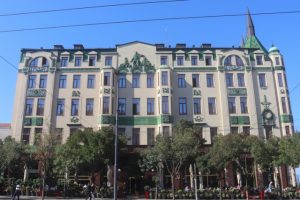
the enormous Hotel Moskva, opposite our apartment, is a great example of Hungarian Secessionist style, Art Nouveau-like
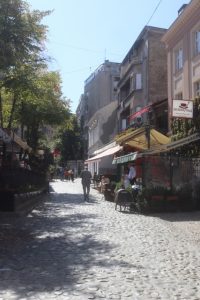
Skadarska street is a pedestrian area full of cafes and bars, and touristic – if there would have been many tourists

lots of people still feel strongly that Kosovo is Serbian, and they also have their views on NATO, harking back to the bombings of 1999
Church of Saint Sava
At one end of the centre is the huge Church of Saint Sava, the world’s second-biggest Orthodox church. The construction of this monstruous temple, allegedly on the site where the Ottoman Turks burnt the remains of Saint Sava, the founder of the Serbian Orthodox Church, started as far back as 1935, but was interrupted by WW II, and subsequently by an atheist communist regime that didn’t approve of the building permits until 1984. Its large dome and its four apses are covered in gold mosaics, with the last donation necessary to complete the work coming from Vladimir Putin in 2019. It is impressive rather than beautiful.
Kalemegdan Fortress
At the other end, where the Sava River which we encountered earlier in Croatia, and the Dunav, Serbian for Danube, come together, is the equally impressive Belgrade Fortress, also called Kalemegdan. This has been a fortress for God knows how long, but the first serious construction was probably carried out by the Romans, in the 2nd C AD – not surprising, at such a strategic confluence. The Byzantine emperor Justinian I rebuild it in the 6th Century, the Bulgarians took it at some stage, and it changed hands a few more times between them, until it became the corner stone of the emerging Serbian state, in the 12th C, Serbian Kingdom and then Empire in the 13th C. It then collapsed in 1389, when Ottoman invaders fought the Serbian army in the battle of Kosovo. Yet it took another 130 years for the Turks to occupy the fort, which they held, with short Austro-Hungarian interruptions, until 1867. The current structure is mostly 18th Century, from both Austro-Hungarian and Ottoman contributions. And it shows in the buildings, there is a hammam and the Sahat tower – clock in Turkish -, and some of the gates show a distinct baroque, Austrian origin. With the departure of the Ottomans, it was generally accepted that the fortress had no strategic value anymore. The only military role it now plays, is as a military museum, with an impressive collection of armoury outside; distinctly post-Ottoman and post-Austro-Hungarian, I think.
… and its churches.
The most attractive structures in the fort are the two churches, the Chapel of Saint Petka, built in 1937 in its present state, and the Ruzica Church, originally 16th C but remodelled in 1869, after the Serbian forces took over the fortress. Both churches are extensively decorated, with fabulous mosaics inside the Ruzica Church, and frescos in the chapel.
The Museums
The efforts to visit the buildings further away, by public transport, were less successful. Not the bus rides: every time we got on and wanted to pay our ticket – which is perfectly possible inside the bus – the driver waved us through, not wanting to charge. But at the ends of our various trips we found the Museum of Contemporary Art having closed its permanent collection, temporarily, and the House of Flowers, which contains Marshall Tito’s mausoleum, a rather underwhelming affair. The big man’s tomb is there, but the attached museum of Yugoslav history was also closed, and the rest of the exhibits not really of great interest to a non-admirer.
But good for us, the most prestigious museum of Belgrade, a private gallery called the Zepter Museum, was open. And didn’t disappoint, in displaying a wonderful collection of works by a wide range of Serbian and ex-Yugoslavian artists, not only early 20th C, but also with more recent work.

the House of Flowers, the museum of Yugoslavia, in an attractive park, which also contains Tto’s Mausoleum
Our sunset cruise, supposed to be the apotheoses of our Belgrade visit, started half an hour late, and there was thus not much sunlight left. And from the water I begin to understand these people that think that Belgrade is actually not a very pretty city. But, altogether a pleasant enough closure of the day, and of our Belgrade experience.
Except that there is more to Belgrade…






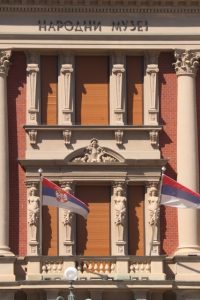

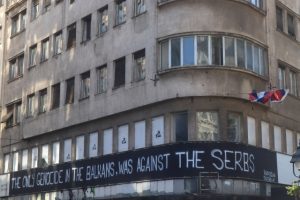


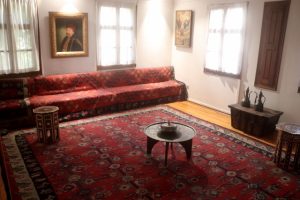



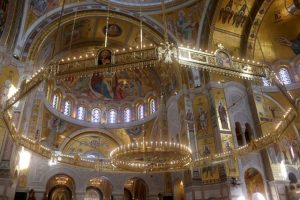
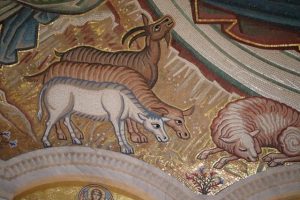





















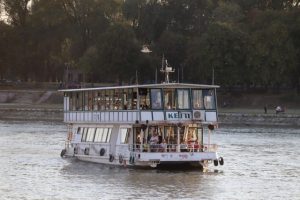






 RSS – Posts
RSS – Posts







